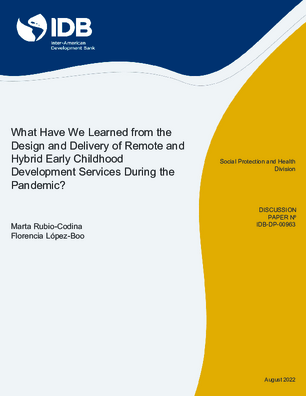What Have We Learned from the Design and Delivery of Remote and Hybrid Early Childhood Development Services During the Pandemic?
Date issued
Aug 2022
Subject
Children;
Early Childhood Development;
Pandemic;
Health;
Home Visit;
Coronavirus;
Virtual Classroom
JEL code
I00 - Health, Education, and Welfare: General: General;
I20 - Education and Research Institutions: General;
I25 - Education and Economic Development;
I38 - Government Policy • Provision and Effects of Welfare Programs;
J13 - Fertility • Family Planning • Child Care • Children • Youth
Category
Discussion Papers
This report provides an in-depth analysis of the efforts that various early childhood programs made to provide hybrid services during the COVID-19 pandemic, efforts that were designed, adapted, implemented, and/or evaluated with the technical and financial support of the Inter-American Development Bank (IDB) in six Latin American and Caribbean countries (Brazil, Colombia, Ecuador, Jamaica, Panama, and Uruguay). It also presents the findings and lessons learned from implementing these services. While the methods used and the information collected are heterogeneous, taken together they provide a relatively broad picture of how these services were implemented. We found that: (i) hybrid approaches made it easier for populations living in remote locations to access services; (ii) the most popular channels were multimedia messages sent via WhatsApp, due to their versatility, followed by video calls, which allowed interactive communication with families; (iii) families and facilitators highly valued maintaining contact every week or every other week, especially at the beginning of the pandemic; (iv) video calls and in-person visits were the strategies used most often to follow up on service quality; (v) play activities that could be integrated into household routines had the highest uptake; (vi) in countries where toy kits were provided, cost and logistical aspects made it necessary to keep them to a minimum; (vii) virtual tools made it possible to individualize services and prepare plans for each child according to their age and level of development; and (viii) in all six countries, facilitators consistently appreciated having materials and a list of suggested activities, although they requested additional training. This report aims to identify aspects of these service delivery approaches that can complement in-person early childhood services at scale in a cost-efficient manner, both for future emergencies and as a way to close gaps in service coverage and other inequities.



